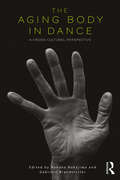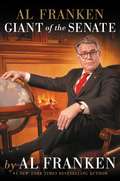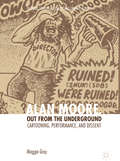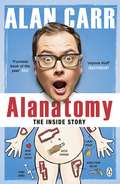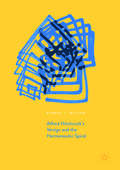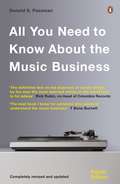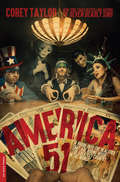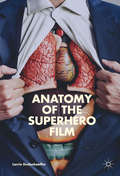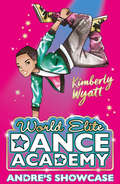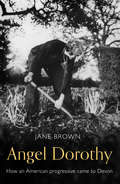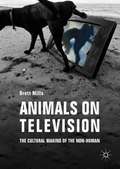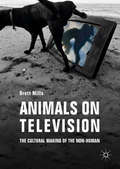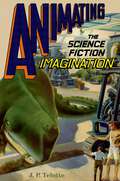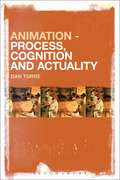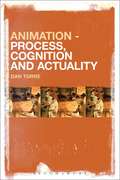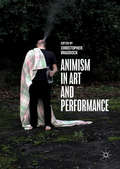- Table View
- List View
The Aging Body in Dance: A cross-cultural perspective
by Gabriele Brandstetter Nanako NakajimaWhat does it mean to be able to move? The Aging Body in Dance brings together leading scholars and artists from a range of backgrounds to investigate cultural ideas of movement and beauty, expressiveness and agility. Contributors focus on Euro-American and Japanese attitudes towards aging and performance, including studies of choreographers, dancers and directors from Yvonne Rainer, Martha Graham, Anna Halprin and Roemeo Castellucci to Kazuo Ohno and Kikuo Tomoeda. They draw a fascinating comparison between youth-oriented Western cultures and dance cultures like Japan’s, where aging performers are celebrated as part of the country’s living heritage. The first cross-cultural study of its kind, The Aging Body in Dance offers a vital resource for scholars and practitioners interested in global dance cultures and their differing responses to the world's aging population.
The Aging Body in Dance: A cross-cultural perspective
by Gabriele Brandstetter Nanako NakajimaWhat does it mean to be able to move? The Aging Body in Dance brings together leading scholars and artists from a range of backgrounds to investigate cultural ideas of movement and beauty, expressiveness and agility. Contributors focus on Euro-American and Japanese attitudes towards aging and performance, including studies of choreographers, dancers and directors from Yvonne Rainer, Martha Graham, Anna Halprin and Roemeo Castellucci to Kazuo Ohno and Kikuo Tomoeda. They draw a fascinating comparison between youth-oriented Western cultures and dance cultures like Japan’s, where aging performers are celebrated as part of the country’s living heritage. The first cross-cultural study of its kind, The Aging Body in Dance offers a vital resource for scholars and practitioners interested in global dance cultures and their differing responses to the world's aging population.
Al Franken, Giant of the Senate
by Al Franken#1 New York Times Bestseller"Flips the classic born-in-a-shack rise to political office tale on its head. I skipped meals to read this book - also unusual - because every page was funny. It made me deliriously happy." - Louise Erdrich, The New York Times p.p1 {margin: 0.0px 0.0px 0.0px 0.0px; font: 15.0px Tahoma; color: #212121; -webkit-text-stroke: #212121} span.s1 {font-kerning: none} From Senator Al Franken - #1 bestselling author and beloved SNL alum - comes the story of an award-winning comedian who decided to run for office and then discovered why award-winning comedians tend not to do that.This is a book about an unlikely campaign that had an even more improbable ending: the closest outcome in history and an unprecedented eight-month recount saga, which is pretty funny in retrospect.It's a book about what happens when the nation's foremost progressive satirist gets a chance to serve in the United States Senate and, defying the low expectations of the pundit class, actually turns out to be good at it.It's a book about our deeply polarized, frequently depressing, occasionally inspiring political culture, written from inside the belly of the beast.In this candid personal memoir, the honorable gentleman from Minnesota takes his army of loyal fans along with him from Saturday Night Live to the campaign trail, inside the halls of Congress, and behind the scenes of some of the most dramatic and/or hilarious moments of his new career in politics.Has Al Franken become a true Giant of the Senate? Franken asks readers to decide for themselves. p.p1 {margin: 0.0px 0.0px 0.0px 0.0px; font: 12.0px Cambria} p.p2 {margin: 0.0px 0.0px 0.0px 0.0px; font: 12.0px Cambria; min-height: 14.0px}
Al Franken, Giant of the Senate
by Al FrankenFrom Senator Al Franken - #1 bestselling author and beloved SNL alum -- comes the story of an award-winning comedian who decided to run for office and then discovered why award-winning comedians tend not to do that. "Flips the classic born-in-a-shack rise to political office tale on its head. I skipped meals to read this book - also unusual - because every page was funny. It made me deliriously happy." -- Louise Erdrich, The New York Times This is a book about an unlikely campaign that had an even more improbable ending: the closest outcome in history and an unprecedented eight-month recount saga, which is pretty funny in retrospect. It's a book about what happens when the nation's foremost progressive satirist gets a chance to serve in the United States Senate and, defying the low expectations of the pundit class, actually turns out to be good at it. It's a book about our deeply polarized, frequently depressing, occasionally inspiring political culture, written from inside the belly of the beast. In this candid personal memoir, the honorable gentleman from Minnesota takes his army of loyal fans along with him from Saturday Night Live to the campaign trail, inside the halls of Congress, and behind the scenes of some of the most dramatic and/or hilarious moments of his new career in politics. Has Al Franken become a true Giant of the Senate? Franken asks readers to decide for themselves.
Alan Moore, Out from the Underground: Cartooning, Performance, and Dissent (PDF)
by Maggie GrayThis book explores Alan Moore’s career as a cartoonist, as shaped by his transdisciplinary practice as a poet, illustrator, musician and playwright as well as his involvement in the Northampton Arts Lab and the hippie counterculture in which it took place. It traces Moore’s trajectory out from the underground comix scene of the 1970s and into a commercial music press rocked by the arrival of punk. In doing so it uncovers how performance has shaped Moore’s approach to comics and their political potential. Drawing on the work of Bertolt Brecht, who similarly fused political dissent with experimental popular art, this book considers what looking strangely at Alan Moore as cartoonist tells us about comics, their visual and material form, and the performance and politics of their reading and making.
Alanatomy: The Inside Story
by Alan Carr***If you loved Alan's first memoir - Look Who It Is! - then his follow-up, Alanatomy, will take you further into the hilarious and bizarre world of the country's favourite chatty man.***'As laugh out loud as his TV shows' Daily MirrorIt must seem strange to you that I've called a book Alanatomy . . . For anyone who has taken the time to see my stand-up performances or watched my chat show, 'Chattyman', knows that my body has hardly been kind to me - in fact there've been times when we've actually stopped talking to each other. Balding, myopic, often flaky with psoriasis, back fat that hangs suspended like a cape, a voice that could strip varnish, an increasingly dodgy hip and even dodgier teeth. Why would you draw attention to it? you must ask. Couldn't you just call the book something else? Do you think the Great British Public is ready to pore over your body? Well, as I turn forty and take stock of my showbiz life over the last ten years or so, I have learnt to embrace my flaws and face my shortcomings. In fact, strange as it might seem, the things I hate about myself have become my trademark and I am slowly, begrudgingly learning to, if not love them, to at least live with them. I am ready now to take a long hard look at myself and that's what Alanatomy is. It's the story of my rise to fame: the joys, the traumas, the parties, the disappointments. Hopefully you will find it witty, fun, heartwarming, but more importantly honest, and that it will keep you entertained every time you pick it up. Alanatomy is the chance for you to get beneath my skin and see the real me because, and to continue the anatomical theme if I may, this showbiz existence can sometimes feel like an autopsy - picked at, probed and scrutinized with every inch of your body held up for analysis, but unlike an actual autopsy, you are very much alive. So I give you Alanatomy: The Inside Story. I am laying myself out on the slab for your entertainment; naked, stripped bare. Grab your scalpel, peel back the skin and go deep, have a good old probe around at my life so far. Yes, you are going to find guts, a fair bit of cheek, maybe even a little bit of gristle, but hopefully, you'll find a whole lot of heart.
Alfred Hitchcock's Vertigo and the Hermeneutic Spiral
by Robert J. BeltonThis book offers a new approach to film studies by showing how our brains use our interpretations of various other films in order to understand Alfred Hitchcock’s Vertigo. Borrowing from behavioral psychology, cognitive science and philosophy, author Robert J. Belton seeks to explain differences of critical opinion as inevitable. The book begins by introducing the hermeneutic spiral, a cognitive processing model that categorizes responses to Vertigo’s meaning, ranging from wide consensus to wild speculations of critical “outliers.” Belton then provides an overview of the film, arguing that different interpreters literally see and attend to different things. The fourth chapter builds on this conclusion, arguing that because people see different things, one can force the production of new meanings by deliberately drawing attention to unusual comparisons. The latter chapters outline a number of such comparisons—including avant-garde films and the works of Stanley Kubrick and David Lynch—to shed new light on the meanings of Vertigo.
Alfred Hitchcock's Vertigo and the Hermeneutic Spiral
by Robert J. BeltonThis book offers a new approach to film studies by showing how our brains use our interpretations of various other films in order to understand Alfred Hitchcock’s Vertigo. Borrowing from behavioral psychology, cognitive science and philosophy, author Robert J. Belton seeks to explain differences of critical opinion as inevitable. The book begins by introducing the hermeneutic spiral, a cognitive processing model that categorizes responses to Vertigo’s meaning, ranging from wide consensus to wild speculations of critical “outliers.” Belton then provides an overview of the film, arguing that different interpreters literally see and attend to different things. The fourth chapter builds on this conclusion, arguing that because people see different things, one can force the production of new meanings by deliberately drawing attention to unusual comparisons. The latter chapters outline a number of such comparisons—including avant-garde films and the works of Stanley Kubrick and David Lynch—to shed new light on the meanings of Vertigo.
All You Need to Know About the Music Business: Eighth Edition
by Donald S PassmanAll You Need To Know About The Music Business - The new edition of 'the industry bible' (Los Angeles Times) by Donald S. PassmanNo one understands the music business and the changes it has undergone in recent years better than LA lawyer Donald Passman. For 20 years his book has offered detailed advice to artists and executives, novices and experts alike on how to thrive in these volatile times.This completely revised edition sets out recent developments in record deals, copyright, new technologies and film music. It also offers unique advice on how to navigate your way through the ins and outs of songwriting, music publishing, merchandising and performing. Whether you're a newcomer or an established professional, All You Need to Know about the Music Business is an essential companion. It will also be loved by readers of The Music Business and How Music Works by David Byrne.'The definitive text on the business of music written by the man the most talented artists in the world look to for advice' Ron Rubin, co-head of Columbia Records'Should be required reading for anyone planning or enduring a career in the biz' Rolling StoneDonald Passman is a graduate of the University of Texas and the Harvard Law School. For many years he has practised law with the LA firm of Gang, Tyre, Ramer and Brown, where he specializes in the music and film industries. He represents many famous music clients. He lives in LA with his wife and four children, and plays guitar and five-string banjo.
America 51: A Probe into the Realities That Are Hiding Inside "The Greatest Country in the World"
by Corey TaylorA skewering of the American underbelly by the New York Times bestselling author of Seven Deadly Sins, A Funny Thing Happened on the Way to Heaven, and You're Making Me Hate You The always-outspoken hard rock vocalist Corey Taylor begins America 51 with a reflection on what his itinerant youth and frequent worldwide travels with his multiplatinum bands Slipknot and Stone Sour have taught him about what it means to be an American in an increasingly unstable world. He examines the way America sees itself, specifically with regard to the propaganda surrounding America's origins (like a heavy-metal Howard Zinn), while also celebrating the quirks and behavior that make a true-blue American. Taylor likewise takes a look at how the world views us, and his findings should come as a surprise to no one. But behind Taylor's ranting and raving is a thoughtful and intelligent consideration, and even a sadness, of what America is compared to what it could and should be. Expertly balancing humor, outrage, and disbelief, Taylor examines the rotting core of America, evaluating everything from politics and race relations to modern family dynamics, millennials, and "man buns." No element of what constitutes America is safe from his adept and scathing eye. Continuing the wave of moral outrage begun in You're Making Me Hate You, Taylor flawlessly skewers contemporary America in his own signature style.
American Horror Fiction and Class: From Poe to Twilight (Palgrave Gothic)
by David SimmonsIn this book, Simmons argues that class, as much as race and gender, played a significant role in the development of Gothic and Horror fiction in a national context. From the classic texts of Edgar Allen Poe and Nathaniel Hawthorne right through to contemporary examples, such as the novels of Stephen King and Stephenie Meyer’s Twilight Series, class remains an ever present though understudied element. This study will appeal to scholars of American Studies, English literature, Media and Cultural Studies interested in class representations in the horror genre from the nineteenth century to the present day.
American Noir: The Pocket Essential Guide to American Crime Fiction, Film & TV (Pocket Essentials)
by Barry ForshawBarry Forshaw is acknowledged as a leading expert on crime fiction and films from Britain and the European countries, but a further area of expertise is American crime fiction, film and TV, as demonstrated in such books as The Rough Guide to Crime Fiction and Detective. After the success of earlier entries in his Noir series - Nordic Noir, Brit Noir and Euro Noir - he now tackles the largest and, some might argue, most impressive body of crime fiction from a single country, the United States, to produce the perfect reader's guide to modern American crime fiction. The word 'Noir' is used in its loosest sense: every major living American writer is considered (including the giants Harlan Coben, Patricia Cornwell, James Lee Burke, James Ellroy and Sara Paretsky, as well as non-crime writers such as Stephen King who stray into the genre), often through a concentration on one or two key books.Many exciting new talents are highlighted, and Barry Forshaw's knowledge of - and personal acquaintance with - many of the writers grants valuable insights into this massively popular field. But the crime genre is as much about films and TV as it is about books, and American Noir is a celebration of the former as well as the latter. US television crime drama in particular is enjoying a new golden age, and all of the important current series are covered here, as well as key important recent films.'The book canters through American Crime fiction of the early 21st century, conveys information in an easily accessible manner and provides a readable overview of the whole area, one that can be dipped into at random, consulted for specific information or read for general interest' - Mystery People'Forshaw's deep knowledge of Noir ensures this is a fascinating guide, as well as a top-notch reading list' - Crime Scene MagazineLook out for the other books in Barry Forshaw's Noir series Euro Noir, Nordic Noir, Brit Noir and Historical Noir, and for his latest book, Crime Fiction: A Reader's Guide.
Amitabh Bachchan (Film Stars)
by Sunny SinghAmitabh Bachchan’s transnational fame as one of cinema’s biggest global stars is both unprecedented and unparalleled. His career spans five decades and stretches the boundaries of the very meaning of stardom. Actor, singer, politician, television host and national icon, he is mobbed by frenzied fans in streets from Mumbai to Cairo, London to Kuala Lumpur, New York to Lagos, and towers like a demi-god in the Indian imagination.In this unique study of the star, Sunny Singh examines Bachchan's film performances and his star persona, locating them in the context of cultural phenomena and global branding, and explores the reasons behind the longevity of his stardom. This illuminating analysis assesses the full range of Bachchan’s work, personality and influence - political, social, economic and technological With in-depth analyses of key films and their wide-ranging social contexts, Singh offers a provocative and in-depth study of the superstar, his extensive career to date as well as the nature of Indian, Asian, and global stardom.
Anatomy of the Superhero Film
by Larrie DudenhoefferThis book addresses what a superhero body can do by developing several “x-rays” of the superbody’s sensoria, anatomic structures, internal systems, cellular organizations, and orthotic, chemical, or technological enhancements. In short, these x-rays offer what we might describe as a metamorpho-physiological approach to the superheroes in feature films, theatrical cartoon shorts, and Netflix television series. This approach examines the ways in which the “substance” of superheroes, which includes their masks, costumes, chevrons, weapons, and auras, extends into the diegetic environment of the film, transgressing it, transforming it, and corporealizing it, making it emblematic of the shape, dimensions, contours, and organismic workings of one or more of our major organs, members, orifices, fluids, or cell clusters. Thus the superhero film, as this study claims, works to make us more aware of the mutability, adaptability, modifiability, and virtual capabilities of our own flesh.
Anatomy of the Superhero Film
by Larrie DudenhoefferThis book addresses what a superhero body can do by developing several “x-rays” of the superbody’s sensoria, anatomic structures, internal systems, cellular organizations, and orthotic, chemical, or technological enhancements. In short, these x-rays offer what we might describe as a metamorpho-physiological approach to the superheroes in feature films, theatrical cartoon shorts, and Netflix television series. This approach examines the ways in which the “substance” of superheroes, which includes their masks, costumes, chevrons, weapons, and auras, extends into the diegetic environment of the film, transgressing it, transforming it, and corporealizing it, making it emblematic of the shape, dimensions, contours, and organismic workings of one or more of our major organs, members, orifices, fluids, or cell clusters. Thus the superhero film, as this study claims, works to make us more aware of the mutability, adaptability, modifiability, and virtual capabilities of our own flesh.
Andre's Showcase (World Elite Dance Academy #3)
by Kimberly WyattThe third book in the World Elite Dance Academy series from international superstar, wellbeing guru and Pussycat Doll, Kimberly Wyatt
Angel Dorothy: How an American Progressive Came to Devon
by Jane BrownAngel Dorothy is the inspiring biography of a formidable woman: wealthy American heiress Dorothy Elmhirst, who poured her considerable resources into founding Dartington Hall in 1925. What started as a progressive school rapidly transformed into a magnet for artists, architects, writers, philosophers and musicians, creating an exceptional centre for British cultural life. It was at Dartington in Devon that the Labour Party’s post-war manifesto was written and the Arts Council was conceived. Born in Washington, DC, into the influential Whitney family, Dorothy was a national darling: bells rang, flags flew and the American Navy’s new fast tugboat was named Dorothy. Orphaned at seventeen, she started giving away her inheritance at eighteen and buried herself in social and political work. She maintained her status as an unmarried woman until she fell in love with and married her first husband, Willard Straight, in 1911. Following Willard’s untimely death, Dorothy worked herself into a breakdown trying to fulfil his wishes. She recovered with the help of Leonard Elmhirst, an Englishman who shared her liberal beliefs; they married and moved to England in 1925 to start what would become Dartington Hall.In this vividly told biography, Jane Brown follows Dorothy from one side of the Atlantic to the other, a journey Dorothy made one hundred times to spread her political beliefs, her passion for education and her support of the arts for all. She traces the evolution of Dartington, from its restoration to its farming and forestry projects, and to its time as a home for the period’s greatest artists and intellectuals.
Animals On Television: The Cultural Making Of The Non-human
by Brett MillsThis book is the first in-depth study of the representation of animals on television. It explores the variety of ways animals are represented in audio-visual media, including wildlife documentaries and children's animated series, and the consequences these representations have for those species. Brett Mills discusses key ideas and approaches essential for thinking about animals drawing on relevant debates in philosophy, politics, gender studies, humanism and posthumanism, and ethics. The chapters examine different animal representations, focusing on zoos, pets, wildlife and meat. They present case studies, including discussions of Peppa Pig, The Hunt and The Dog Whisperer. This book will be of interest to readers exploring media studies, contemporary television, animal studies, and debates about representation.
Animals On Television: The Cultural Making Of The Non-human (PDF)
by Brett MillsThis book is the first in-depth study of the representation of animals on television. It explores the variety of ways animals are represented in audio-visual media, including wildlife documentaries and children's animated series, and the consequences these representations have for those species. Brett Mills discusses key ideas and approaches essential for thinking about animals drawing on relevant debates in philosophy, politics, gender studies, humanism and posthumanism, and ethics. The chapters examine different animal representations, focusing on zoos, pets, wildlife and meat. They present case studies, including discussions of Peppa Pig, The Hunt and The Dog Whisperer. This book will be of interest to readers exploring media studies, contemporary television, animal studies, and debates about representation.
Animals on Television: The Cultural Making of the Non-Human
by Brett MillsThis book is the first in-depth study of the representation of animals on television. It explores the variety of ways animals are represented in audio-visual media, including wildlife documentaries and children’s animated series, and the consequences these representations have for those species. Brett Mills discusses key ideas and approaches essential for thinking about animals drawing on relevant debates in philosophy, politics, gender studies, humanism and posthumanism, and ethics. The chapters examine different animal representations, focusing on zoos, pets, wildlife and meat. They present case studies, including discussions of Peppa Pig, The Hunt and The Dog Whisperer. This book will be of interest to readers exploring media studies, contemporary television, animal studies, and debates about representation.
ANIMATING THE SCIENCE FICTION FILM C
by J.P. TelotteLong before flying saucers, robot monsters, and alien menaces invaded our movie screens in the 1950s, there was already a significant but overlooked body of cinematic science fiction. Through analyses of early twentieth-century animations, comic strips, and advertising, Animating the Science Fiction Imagination unearths a significant body of cartoon science fiction from the pre-World War II era that appeared at approximately the same time the genre was itself struggling to find an identity, an audience, and even a name. In this book, author J.P. Telotte argues that these films helped sediment the genre's attitudes and motifs into a popular culture that found many of those ideas unsettling, even threatening. By binding those ideas into funny and entertaining narratives, these cartoons also made them both familiar and non-threatening, clearing a space for visions of the future, of other worlds, and of change that could be readily embraced in the post-war period.
Animation – Process, Cognition and Actuality
by Dan TorreAnimation - Process, Cognition and Actuality presents a uniquely philosophical and multi-disciplinary approach to the scholarly study of animation, by using the principles of process philosophy and Deleuzian film aesthetics to discuss animation practices, from early optical devices to contemporary urban design and installations. Some of the original theories presented are a process-philosophy based theory of animation; a cognitive theory of animation; a new theoretical approach to the animated documentary; an original investigative approach to animation; and unique considerations as to the convergence of animation and actuality. Numerous animated examples (from all eras and representing a wide range of techniques and approaches – including television shows and video games) are examined, such as Fantastic Mr. Fox (2009), Madame Tutli-Putli (2007), Gertie the Dinosaur (1914), The Peanuts Movie (2015), Grand Theft Auto V (2013) and Dr. Katz: Professional Therapist (1995–2000). Divided into three sections, each to build logically upon each other, Dan Torre first considers animation in terms of process and process philosophy, which allows the reader to contemplate animation in a number of unique ways. Torre then examines animation in more conceptual terms in comparing it to the processes of human cognition. This is followed by an exploration of some of the ways in which we might interpret or 'read' particular aspects of animation, such as animated performance, stop-motion, anthropomorphism, video games, and various hybrid forms of animation.He finishes by guiding the discussion of animation back to the more tangible and concrete as it considers animation within the context of the actual world. With a genuinely distinctive approach to the study of animation, Torre offers fresh philosophical and practical insights that prompt an engagement with the definitions and dynamics of the form, and its current literature.
Animation – Process, Cognition and Actuality
by Dan TorreAnimation - Process, Cognition and Actuality presents a uniquely philosophical and multi-disciplinary approach to the scholarly study of animation, by using the principles of process philosophy and Deleuzian film aesthetics to discuss animation practices, from early optical devices to contemporary urban design and installations. Some of the original theories presented are a process-philosophy based theory of animation; a cognitive theory of animation; a new theoretical approach to the animated documentary; an original investigative approach to animation; and unique considerations as to the convergence of animation and actuality. Numerous animated examples (from all eras and representing a wide range of techniques and approaches – including television shows and video games) are examined, such as Fantastic Mr. Fox (2009), Madame Tutli-Putli (2007), Gertie the Dinosaur (1914), The Peanuts Movie (2015), Grand Theft Auto V (2013) and Dr. Katz: Professional Therapist (1995–2000). Divided into three sections, each to build logically upon each other, Dan Torre first considers animation in terms of process and process philosophy, which allows the reader to contemplate animation in a number of unique ways. Torre then examines animation in more conceptual terms in comparing it to the processes of human cognition. This is followed by an exploration of some of the ways in which we might interpret or 'read' particular aspects of animation, such as animated performance, stop-motion, anthropomorphism, video games, and various hybrid forms of animation.He finishes by guiding the discussion of animation back to the more tangible and concrete as it considers animation within the context of the actual world. With a genuinely distinctive approach to the study of animation, Torre offers fresh philosophical and practical insights that prompt an engagement with the definitions and dynamics of the form, and its current literature.
Animism in Art and Performance
by Christopher BraddockThis book explores Māori indigenous and non-indigenous scholarship corresponding with the term ‘animism’. In addressing visual, media and performance art, it explores the dualisms of people and things, as well as 'who' or 'what' is credited with 'animacy'. It comprises a diverse array of essays divided into four sections: Indigenous Animacies, Atmospheric Animations, Animacy Hierarchies and Sensational Animisms. Cassandra Barnett discusses artists Terri Te Tau and Bridget Reweti and how personhood and hau (life breath) traverse art-taonga. Artist Natalie Robertson addresses kōrero (talk) with ancestors through photography. Janine Randerson and sound artist Rachel Shearer consider the sun as animate with mauri (life force), while Anna Gibb explores life in the algorithm. Rebecca Schneider and Amelia Jones discuss animacy in queered and raced formations. Stephen Zepke explores Deleuze and Guattari's animist hylozoism and Amelia Barikin examines a mineral ontology of art. This book will appeal to readers interested in indigenous and non-indigenous entanglements and those who seek different approaches to new materialism, the post-human and the anthropocene.
Animism in Art and Performance
by Christopher BraddockThis book explores Māori indigenous and non-indigenous scholarship corresponding with the term ‘animism’. In addressing visual, media and performance art, it explores the dualisms of people and things, as well as 'who' or 'what' is credited with 'animacy'. It comprises a diverse array of essays divided into four sections: Indigenous Animacies, Atmospheric Animations, Animacy Hierarchies and Sensational Animisms. Cassandra Barnett discusses artists Terri Te Tau and Bridget Reweti and how personhood and hau (life breath) traverse art-taonga. Artist Natalie Robertson addresses kōrero (talk) with ancestors through photography. Janine Randerson and sound artist Rachel Shearer consider the sun as animate with mauri (life force), while Anna Gibb explores life in the algorithm. Rebecca Schneider and Amelia Jones discuss animacy in queered and raced formations. Stephen Zepke explores Deleuze and Guattari's animist hylozoism and Amelia Barikin examines a mineral ontology of art. This book will appeal to readers interested in indigenous and non-indigenous entanglements and those who seek different approaches to new materialism, the post-human and the anthropocene.
